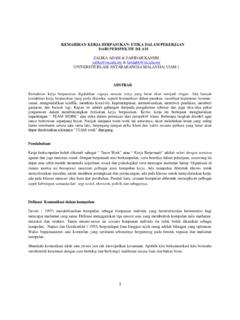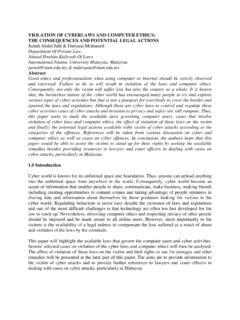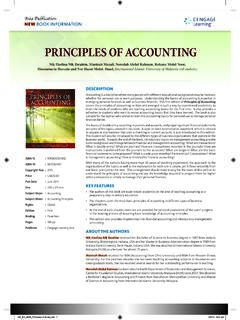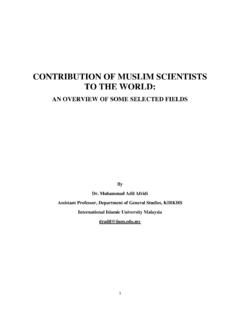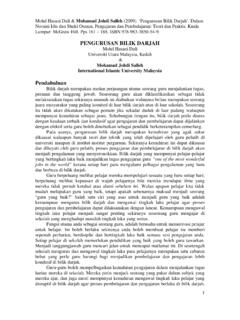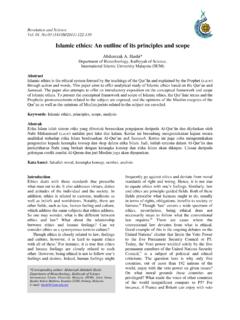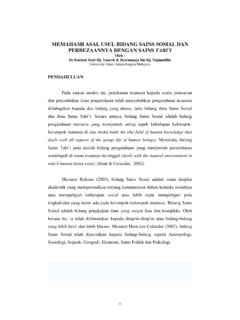Transcription of UNDERSTANDING OF LAWS AND REGULATIONS ON HALAL …
1 LAWS AND REGULATIONS ON HALAL PRODUCTION Noriah RamliINHART, IIUMUSIM-HDC HALAL EXECUTIVE PROGRAMME on HALAL production is very much needed as the non-Muslim manufacturers also produce food offered for sale 2. To protect the consumers ensure that halalfood producers fulfill their moral obligation towards the consumersto carry out their business fairly, sincerely, transparent and consumer friendly,3. To facilitate halalfood trade for both local and global market. The Act will stand as a guidelineto all Muslim and non-Muslim food manufacturers Laws And REGULATIONS Trade Description Act: Ministry of Domestic Trade and Consumer Affairs. the law is enforced in cooperation with several government agencies:Department of Veterinary Services, Ministry of Health, Ministry of Domestic Trade and Consumer Affairs headed by JAKIM and at state level it is headed by the State Department of Religious Description Act 1972 Section 10 of the Act 1972 allows the Minister to enact the Trade Descriptions (Use Of Expression HALAL ) Order 1975.
2 Section 3 of the Order 1975 allows the use of the expression HALAL , Di-tanggongHalal or MakananIslam in relations to food to indicate that Muslims are permitted by their religion to consume such food item. section 3 of the Order has a similar definition of halalfood with the definition given by JAKIM s Guidelines on Food and Drinks and Goods Utilisedby the Muslim 1994. Trade Descriptions (Marking of Food) Order, 1975(made under the Trade Description Act 1972) requires food which is HALAL according to the Trade Description (Use of Expression HALAL ) Order 1975 must not be supplied unless marked with a Food Industry Centre (JAFIC 9th-10th December 2009 Remark/Observation: The Trade Description Act 1975, though it contains a provision for the use of the HALAL label, the Act however does not specify the conditions and the procedure for the grant of thehalallabelCustom Order (Prohibition of Imports) 1988 This Order provides a control over the import of milk and milk products, poultry fat, lard, pig fat and others Requires that all meat and livestock imported into Malaysia to be Importation Order 1962 It is a requirement that all meat and livestock must be HALAL ,safe and disease free.)
3 Enforced by the Department of Veterinary Services and the Customs and Excise Department at entry points in REGULATIONS 1985 Regulation 11 (1) (c) provides that where the food contains beef or pork, or its derivatives, or lard, a statement of its presence in that food should be written on the label. Regulation 11 (d):requires that food that contains alcohol to be label as Although the Food REGULATIONS 1985 requires the presence of non- HALAL substance to be declared on the label, nevertheless, the provision is insufficient to govern the various matters related to HALAL food productionLocal Government Act 1976 Section 20D (1) (a), (b) of the Licensing of Food Establishments (Federal Territory of Kuala Lumpur) (Amendment) By-Laws 1995,requires the licensee to wash utensils used for non-halalfood separately from those used for the halalfood It is also a requirement that the utensils used for the non-halalfood should not be used for the preparation and serving of the halalfood.
4 Sub-section (3) states that if the premises only serves non-halalfood then the licensee must at all times display on the menu the words Non-HalalFood Only .Guideline/Code of Practice Guidelines on Foods, Drinks and Goods Utilized by Muslims(issued by JAKIM in 1984) elaborate the use of the term HALAL , ditanggung HALAL ,and makanan orang Islam under section 3 of the Trade Description (Use of Expression HALAL ) Order 1975. explain to food processors and the public, the halaland haramaspects as stipulated by Shariahlaw. defines halalfood and drinks, slaughtering, processing, handling, labelling and utensils used by Muslims. General Guidelines on the Slaughtering of Animals and the Preparation and Handling of HALAL Food. issued by JAKIM for the slaughtering of animals and the preparation and storage of halalfood. to be observed by all establishments involved in the processing of halalfood.
5 Also applicable to all foreign establishments intending to export their products to Malaysia should be used together with existing guidelines on GMP and hygienic sanitary requirements. MS 1500:2009- HALAL Food-Production, Preparation, Handling and Storage-General Guidelines (2ndRevision) requirement that the Standard is to be used together with Food Safety according to hazard analysis and critical control point (HACCP) system, General principles of food hygiene and Guidelines on good hygiene practices for small and medium scale food industries towards HACCP MOH/K/ (GU).MS STANDARDS ON HALALFOOD the World Trade Organization (WTO), SPS (Sanitary and Phytosanitary) WTO Agreement Series, 4, Sanitary & Phytosanitary Measures, Switzerland, 1998, XII-1998-2, 500. and TBT (Technical Barriers to Trade) SPS: The SPS Agreement covers food safety and animal and plant health protection.
6 It gives the governments the right to give priority to health protection over trade. The need for trade restrictions in order to ensure health protection, however, must be scientifically justified, either on the basis of Codex Standards, guidelines or recommendations for food safety, or based on risk assessment. The Sanitary or phytosanitary measures include all relevant laws, REGULATIONS , requirements and procedures including, inter alia, end product criteria; process and production methods; testing, inspection, certification and approval procedures; quarantine treatments including relevant requirements associated with the transportation of animals, : The TBT Agreement on the other hand covers mandatory technical REGULATIONS and voluntary standards and conformity assessment procedures, with the right of the governments to apply REGULATIONS needed to achieve legitimate objectives, including protection from deceptive practices.
7 The five principles of the TBT Agreement are non-discrimination, harmonization, avoidance of unnecessary trade barriers, equivalance or mutual recognition and Allimentarius: Agreements recognized Codex AlimentariusCommission as the international reference for food standards to protect human health and life. Apart from Codex the other international bodies include the OIE (Office of the Epizootics), addressing animal health and life and the IPPC (International Plant Protection Congress) that looks into plant health and lifeCodex Standard on the Use of the Term HALAL in 1997, Codex adopted the General Guidelines for the Use of the Term HALAL . In the guideline it is stated clearly that there may be minor differencesin opinion in the interpretation of lawful and unlawful animals and in the slaughter act, according to the different Islamic Schools of Thought.
8 As such, the guidelines are subjected to the interpretation of the appropriate authorities of the importing for the Slaughter of Small Ruminants in Developing Countries The FAO Animal Production and Health Paper 49, 1985 sets out the guidelines for the slaughter of sheep and goats in developing countries. The guidelines covers the slaughtering procedures based on religious and traditional observance including Islamic STANDARDS ON HALALFOOD Apart from the international halalfood standards and guidelines, there are alsohalalfood guidelines at the Regional level. In 1998, ASEAN adopted the guidelines onhalalfood handling and in 1999 endorsed the ASEAN HalalLogo with the objective to facilitate trade in the region. The ASEAN Guidelines on The Preparation and Handling of HalalFood serve as a practical guide for the food industries in the production and handling of REGULATIONS HALAL from farm to table.
9 Authenticity of HALAL production does not solely depend on the legal mechanisms but also to the various administrative mechanisms enforced by the relevant government agencies in Malaysia. various codes of practice such as Good Manufacturing Practice, HACCP Guidelines, Good Aquaculture Practice (GAqP), Good Animal husbandry Practice (GAHP), Good Agricultural practice (GAP) etc. LICENSING OF FOOD BUSINESS Local Government Act 1976 Section72(1)(c)(i)oftheLocalGovernmentAc t1976empowersthelocalauthoritytolicensea nytemporarybuildings,stallsorotherrecept aclesusedforthesaleofanyfoodanddrinks. Thedetailedprovisionswerecontainedinanum berofby-lawsenactedundersection73(1)ofth eLocalGovernmentAct1976. StateAuthority CityCouncil,MunicipalCouncilorDistrictCo uncil , AND ANIMALS RELATED ACTIVITIES With regards to food safety, it is a requirement that the licence to import animal drugs is to be given to pharmacists only.
10 The Poisons Act 1952 (Revised 1989),though not specifically enacted to govern matters related to food, nevertheless, is relevant in the importation and use of veterinary drugs in animal production. The Poisons Act 1952 came into force in Malaya on 1st December 1952 and extended to East Malaysia on 1st June 1978. The Animals (Importation) Order 1962 requires that all meat and livestock imported into Malaysia to be HALAL , safe and disease free. Lembaga Kemajuan Perusahaan Haiwan Negara (Control of Slaughter) Rules 1975 was enacted to regulate the slaughter of livestock at the approved abattoir and to permit slaughter outside the abattoir area. Section 8(2) of the Act prohibits livestocks slaughtered outside the approved abattoir, to be disposed for human consumption unless provided with a warranty that such animal is free from diseases and safe for ENACTMENT Part III, section 6(1), (2) of the Control and Licensing of Poultry Farming and Poultry Related Activities (Negeri Sembilan) Enactment 1996, provides that no person shall carry out poultry farming or any poultry related activity unless within licence issued under the Enactment.
